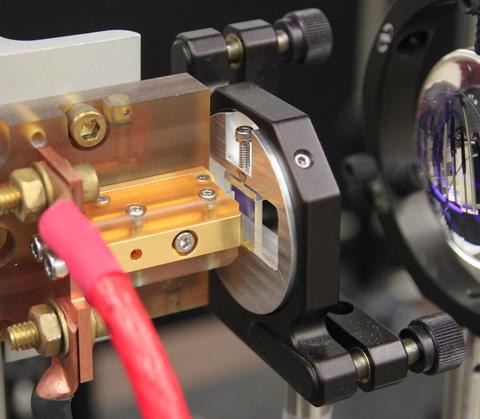Applied: Pushing and Understanding the Limits of Spin-Exchange Optical Pumping of 3He
Summary
Neutron spin filters based on polarized 3He rely on the strong spin dependence of the absorption of neutrons by 3He gas.
Description

A high power diode array laser followed by a “chirped” volume Bragg grating (VBG) that provides feedback to spectrally narrow the laser light by an order of magnitude. This new scheme for spectral narrowing has led to increased 3He polarization for neutron spin filters polarized by spin-exchange optical pumping.
The efficiency of these devices is strongly dependent on the achievable 3He polarization. The two optical pumping methods for polarizing 3He for neutron spin filters are metastability-exchange and spin-exchange; in the former 3He nuclei are polarized through optically pumped metastable 3He atoms while in the latter 3He nuclei are polarized via spin-exchange with alkali-metal atoms. For spin filter applications, both methods are currently limited to 75 % - 80 % 3He polarization, although the physics behind the limits is quite different for the two methods. For the spin-exchange optical pumping (SEOP) method employed at NIST we reported that even under conditions where one would have expected to approach 100 % 3He polarization, only 75 % - 80 % was observed. In collaboration with the Univ. of Wisconsin, this limit was found to be associated with an unexpected temperature dependence of the 3He polarization relaxation time. However, recent work with a new scheme for operating lasers for SEOP have added a new twist in this analysis.
In the SEOP method, alkali-metal atoms are polarized by optical pumping with high power diode array lasers that are spectrally narrowed to increase the absorption. To increase efficiency, we have recently replaced an external cavity design for spectral narrowing with "chirped" volume Bragg gratings (VBGs) (see figure 1). A VBG is a photorefractive optical element that provides feedback to the diode array laser to narrow its bandwidth by an order of magnitude; for a chirped VBG, the feedback wavelength varies across the element to allow the spectrally narrowed peak to be accurately matched to the alkali-metal absorption. A unanticipated "windfall" was an increase to 85 % for the maximum 3He polarization observed. This increase has improved the performance of our spin filters, but its origin is not well understood. The chirped VBG approach typically yields 15 % higher power and somewhat less broadband background than the external cavity scheme. This better performance was expected to improve the polarizing rate, but was not expected to improve the alkali-metal polarization because previous work had indicated that it was already nearly unity. Nevertheless, the most likely explanation is that for our large spin filter cells, the alkali-metal polarization was not 100% at all points within the cell. In collaboration with the NCNR, we have investigated the origin of the observed polarization increase, but the origin is still unclear. This work is summarized in W. Chen, T.R. Gentile, Q. Ye, T.G. Walker and E. Babcock, J. Appl. Phys. 116, 014903 (2014). Using increased laser power in the NCNR SEOP apparatus a record value of 88% 3He polarization has now been achieved. More recent studies with a commercial laser that operates with nearly another order of magnitude reduction in spectral bandwidth compared to our usual lasers did not yield any improvement in 3He polarization.
The holy grail of 100% 3He polarization is a difficult trail, but a successful outcome would not only yield significant improvement of neutron spin filters, but would also have impact on medical imaging and accelerator-based nuclear and particle physics. In addition to practical issues for application of spin filters our program includes ongoing efforts with relaxation studies, accurate polarization measurements, and optical pumping that will allow us continue to push and understand the limits of the SEOP method.

